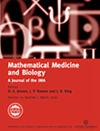A structured model for COVID-19 spread: modelling age and healthcare inequities
IF 1.5
4区 数学
Q4 BIOLOGY
Mathematical Medicine and Biology-A Journal of the Ima
Pub Date : 2020-05-21
DOI:10.1101/2020.05.17.20104976
引用次数: 16
Abstract
We use stochastic branching process model, structured by age and level of healthcare access, to look at the heterogeneous spread of COVID-19 within a population. We examine the effect of control scenarios targeted at particular groups, such as school closures or social distancing by older people. Although we currently lack detailed empirical data about contact and infection rates between different age groups and groups with different levels of healthcare access within New Zealand, these scenarios illustrate how such evidence could be used to inform specific interventions. We find that an increase in the transmission rates amongst children as a result of reopening schools is, on its own, unlikely to significantly increase the number of cases. However, if this is accompanied by a change in adult behaviour, for example increased contact rates among parents, it could have a much bigger effect. We also find that there is a risk of undetected outbreaks occurring in communities that have low access to healthcare and that are socially isolated from more privileged communities. The greater the inequity and the greater the degree of social segregation, the longer it will take before any outbreaks are detected. Well-established evidence for health inequities, particularly in accessing primary healthcare and testing, indicates that M[a]ori and Pacific peoples are at higher risk of undetected outbreaks in Aotearoa New Zealand. This highlights the importance of ensuring that community needs for access to healthcare, including early proactive testing, rapid contact tracing, and the ability to isolate, are being met equitably. Finally, these scenarios illustrate how information concerning contact and infection rates across different demographic groups may be useful in informing specific policy interventions.新冠肺炎传播的结构化模型:年龄和医疗不平等模型
我们使用随机分支过程模型,根据年龄和医疗保健水平构建,来观察新冠肺炎在人群中的异质传播。我们研究了针对特定群体的控制情景的影响,例如学校关闭或老年人保持社交距离。尽管我们目前缺乏关于新西兰不同年龄组和医疗服务水平不同的群体之间的接触率和感染率的详细经验数据,但这些情景说明了如何利用这些证据为具体干预措施提供信息。我们发现,由于学校重新开放,儿童传播率的增加本身不太可能显著增加病例数量。然而,如果这伴随着成年人行为的改变,例如父母之间的接触率增加,可能会产生更大的影响。我们还发现,在获得医疗保健的机会较低、与更优越的社区社会隔离的社区,存在未被发现的疫情爆发的风险。不公平现象越严重,社会隔离程度越高,发现任何疫情所需的时间就越长。健康不平等的既定证据,特别是在获得初级医疗保健和检测方面,表明毛利人和太平洋地区的人在新西兰奥特亚罗阿爆发未被发现的疫情的风险更高。这突出了确保公平满足社区获得医疗保健的需求的重要性,包括早期主动检测、快速接触者追踪和隔离能力。最后,这些情景说明了不同人口群体的接触率和感染率信息如何有助于为具体的政策干预提供信息。
本文章由计算机程序翻译,如有差异,请以英文原文为准。
求助全文
约1分钟内获得全文
求助全文
来源期刊
CiteScore
2.20
自引率
0.00%
发文量
15
审稿时长
>12 weeks
期刊介绍:
Formerly the IMA Journal of Mathematics Applied in Medicine and Biology.
Mathematical Medicine and Biology publishes original articles with a significant mathematical content addressing topics in medicine and biology. Papers exploiting modern developments in applied mathematics are particularly welcome. The biomedical relevance of mathematical models should be demonstrated clearly and validation by comparison against experiment is strongly encouraged.
The journal welcomes contributions relevant to any area of the life sciences including:
-biomechanics-
biophysics-
cell biology-
developmental biology-
ecology and the environment-
epidemiology-
immunology-
infectious diseases-
neuroscience-
pharmacology-
physiology-
population biology

 求助内容:
求助内容: 应助结果提醒方式:
应助结果提醒方式:


